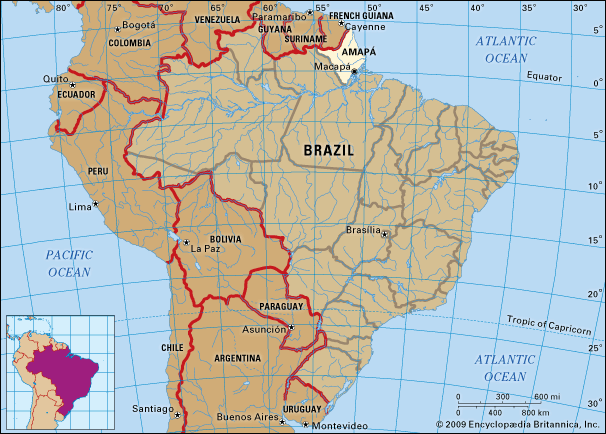Amapá
Amapá, estado (state), northern Brazil. It is bounded on the north by a small portion of Suriname and by French Guiana, on the northeast by the Atlantic Ocean, on the south and west by the Brazilian state of Pará, and on the southeast by the Amazon River. Formerly a part of Pará state, Amapá was created a territory in 1943 and became a state in 1990, with its capital at Macapá. Most of the state is tropical rainforest, and there are patches of savanna along the coast, which has long remained scantily populated. In the early 21st century several notable conservation efforts were undertaken to protect Amapá’s diverse fauna and flora. In 2002 Tumucumaque National Park—the world’s largest tropical forest park, with an area of about 15,000 square miles (39,000 square km)—was created. The park is part of the Amapá Biodiversity Corridor, a protected area that was established in 2003. The corridor covers more than 70 percent of the state. By the second decade of the 21st century, however, the state’s ecology had begun to be transformed by increasing oil exploration and mining activity along with the development of agribusiness, especially soybean cultivation.
Amapá’s major products are cabinet and papermaking woods (mahogany, cedar, pine, eucalyptus, and rosewood), soybeans, medicinal plants, wild-animal skins, rubber, jute, Brazil nuts, fish, crustaceans, and mollusks. Gold is found in the stream gravels. Amapá is also the site of manganese and iron ore mines. In the late 1970s factories were built to produce ferromanganese and silicomanganese from the mines’ ore. Water pollution from mining has been a growing problem. Oil was discovered in the continental shelf off Amapá state, and oil exploration increased in the first decades of the 21st century. Small-scale agriculture traditionally has supported a large proportion of the population, with many others earning their living from the fishing industry, but this way of life has been impacted by development of agribusiness and the potential threat of pollution caused by the oil and mining industries. Macapá’s port (Pôrto Santana), highways, and railroad link Macapá to the state’s interior and to northwestern Brazil. Area 55,141 square miles (142,815 square km). Pop. (2022) 774,268.












